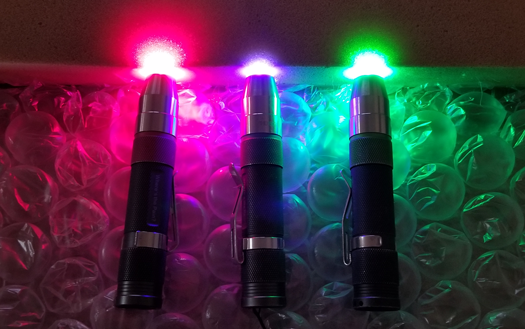Photonic Therapy
Photonic Therapy is an advanced form of traditional complementary therapy using a specific colour light to stimulate recognized acupuncture points. This therapy is also referred to as Photobiomodulation (PBM), cold laser, low-level laser therapy or laser acupuncture. Photonic therapy is a safe, natural and non-invasive way to promote healing and control pain. Photonic therapy works because the body’s tissue can absorb the light at a cellular level, converting it to cellular energy as ATP. Many studies have shown that this energy accelerates activity in the mitochondria of the cell, as well as improving blood flow in the area being treated, speeding healing and minimizing pain. As the brain signals to release endorphins and serotonin into the body, additional benefits include strengthening the immune system, increasing antiviral properties and providing a deep sense of relaxation.
We use a variety of light colours as each has their own specific benefits to the body:
Using the principles of acupuncture, Photonic Therapy assists with joint and muscle pain, wound management, burn treatment, skin disorders and sports injuries. The brain receives signals to release endorphins (natural pain killers) and serotonin into the body. This chain reaction:
- Reduces pain and swelling
- Increases lymphatic activity
- Strengthens the immune system
- Accelerates cell regeneration
- Increases circulation
- Relaxes muscles
- Increases anti-viral properties
- Encourages collagen production
- Regulates serotonin levels
What to Expect
A light source is placed near or in contact with the skin, allowing the light energy (photons) to penetrate tissue where it interacts with chromophores located in cells. This interaction results in photophysical and photochemical changes that lead to alterations at the molecular, cellular and tissue levels of the body.
Light induces a complex chain of physiological reactions in diseased and damaged tissues to accelerate wound healing and tissue regeneration, increase circulation, reduce acute inflammation, reduce acute and chronic pain and help restore normal cellular function. Interestingly, recent research indicates that light can enhance performance in normal tissues and cells.
Photobiomodulation (PBM) Therapy uses red and near infrared (NIR) light to reduce pain, inflammation and edema, and drastically aid recovery. PBM therapy works at the cellular level, stimulating repair and normalizing cell function.
Acute injuries and inflammation from muscle strains and sprains, cuts, bruises, burns, etc. typically show very rapid improvement and can resolve in 2-4 treatments. Long-term, chronic conditions can take as little as 12 sessions to see significant benefits. Minimum interval recommendation is 2-3 times per week until your goals are met, then 1-2 times per week for ongoing maintenance. For individuals who exercise frequently or at high levels, 3-5 times per week is recommended for optimal recovery.
Research and Studies
The therapeutic use of visible and NIR light has been studied for almost forty years. Over 600 Randomized Controlled Trials (RCTs) have been published using PBM devices, and the technology has been featured in over 4,000 laboratory studies. PBM is used in thousands of clinics, hospitals and elite sports institutions in over 70 nations. Here is just a sampling of these studies:
Photobiomodulation or low-level laser therapy
What Is Photobiomodulation Therapy?
Effects of photobiomodulation therapy in patients with chronic non-specific low back pain
Shining light on the head: Photobiomodulation for brain disorders
Photobiomodulation: lasers vs. light emitting diodes?
LLLT/PBM/Red/NIR phototherapy studies – A Comprehensive Database
Non-mammalian Hosts and Photobiomodulation: Do All Life-forms Respond to Light?
A light source is placed near or in contact with the skin, allowing the light energy (photons) to penetrate tissue where it interacts with chromophores located in cells. This interaction results in photophysical and photochemical changes that lead to alterations at the molecular, cellular and tissue levels of the body.
Light induces a complex chain of physiological reactions in diseased and damaged tissues to accelerate wound healing and tissue regeneration, increase circulation, reduce acute inflammation, reduce acute and chronic pain and help restore normal cellular function. Interestingly, recent research indicates that light can enhance performance in normal tissues and cells.
Photobiomodulation (PBM) Therapy uses red and near infrared (NIR) light to reduce pain, inflammation and edema, and drastically aid recovery. PBM therapy works at the cellular level, stimulating repair and normalizing cell function.
Acute injuries and inflammation from muscle strains and sprains, cuts, bruises, burns, etc. typically show very rapid improvement and can resolve in 2-4 treatments. Long-term, chronic conditions can take as little as 12 sessions to see significant benefits. Minimum interval recommendation is 2-3 times per week until your goals are met, then 1-2 times per week for ongoing maintenance. For individuals who exercise frequently or at high levels, 3-5 times per week is recommended for optimal recovery.
Research and Studies
The therapeutic use of visible and NIR light has been studied for almost forty years. Over 600 Randomized Controlled Trials (RCTs) have been published using PBM devices, and the technology has been featured in over 4,000 laboratory studies. PBM is used in thousands of clinics, hospitals and elite sports institutions in over 70 nations. Here is just a sampling of these studies:
Photobiomodulation or low-level laser therapy
What Is Photobiomodulation Therapy?
Effects of photobiomodulation therapy in patients with chronic non-specific low back pain
Shining light on the head: Photobiomodulation for brain disorders
Photobiomodulation: lasers vs. light emitting diodes?
LLLT/PBM/Red/NIR phototherapy studies – A Comprehensive Database
Non-mammalian Hosts and Photobiomodulation: Do All Life-forms Respond to Light?


